Write and edit source code
When you work with code, JetBrains DataSpell ensures that your work is stress-free. It offers various shortcuts and features to help you add, select, copy, move, edit, fold, find occurrences, and save code.
Use JetBrains DataSpell editor, the main part of the IDE, to create, read and modify code.
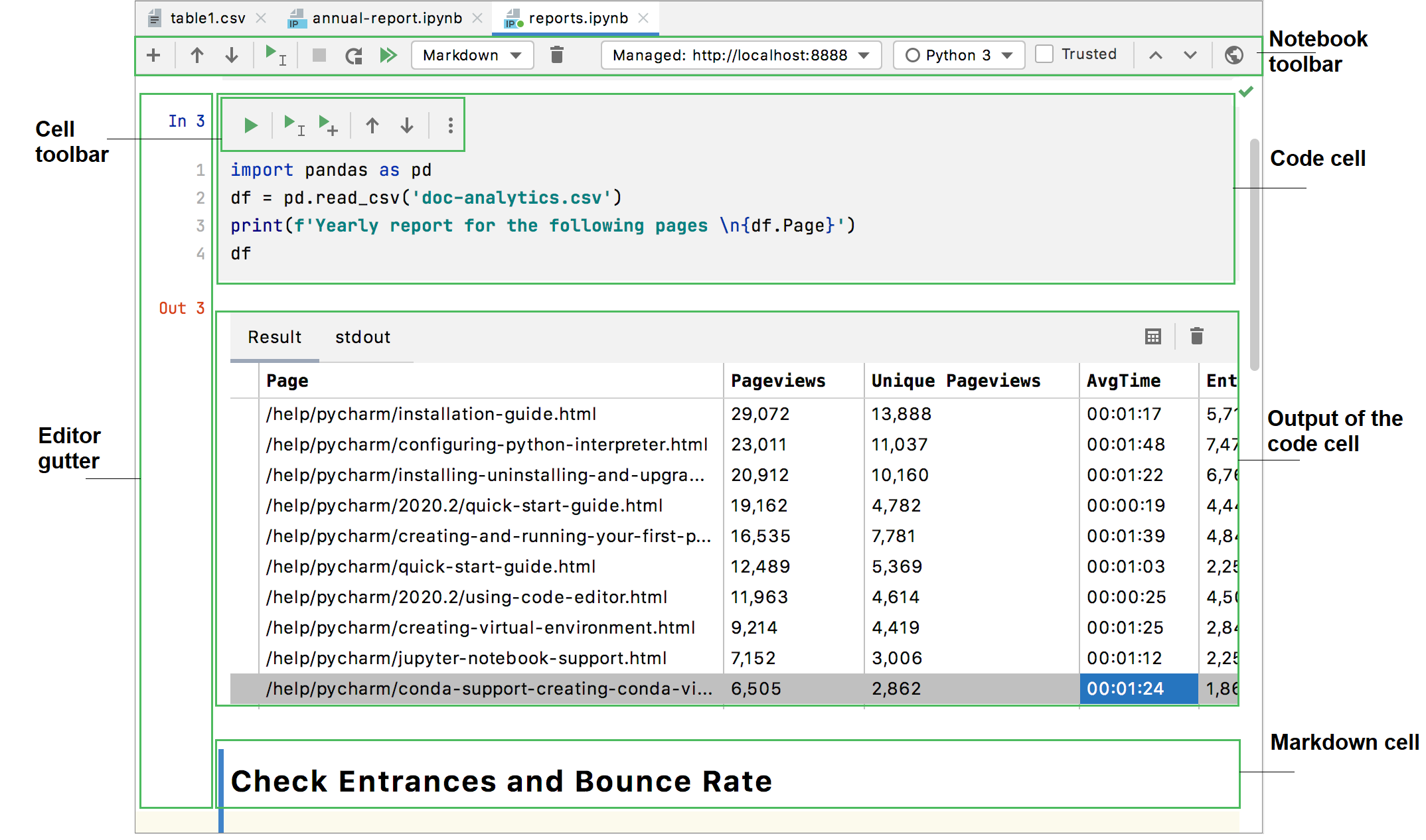
A Jupyter notebook opened in the editor has its specific UI elements:
Jupyter notebook toolbar: provides quick access to the most popular actions. The rest of the notebook specific actions are available in the menu.
Code cell: a notebook cell that contains an executable code
Cell output: results of the code cell execution; can be presented by a text output, table, or plot.
Cell toolbar: a toolbar of the code cell with the most popular commands. By default, cell toolbars are disabled. To enable them, open project settings/preferences (Ctrl+Alt+S ), go to , and select the Show cell toolbar checkbox.
For navigation inside the editor, refer to Editor basics.
Find action
If you do not remember a shortcut for the action you want to use, press Ctrl+Shift+A to find any action by name.
Add a new notebook or file
In the editor, press Ctrl+Alt+Insert to add a notebook or file.
If the focus is inside the Project tool window and you want to add a new element, press Alt+Insert.
Select code constructs
In the editor, place the caret at the item you want to select and press Ctrl+W/ Ctrl+Shift+W to extend or shrink your selection.
For example, in a plain text file, the selection starts within the whole word then extends to the sentence, paragraph, and so on.
If you need just to highlight your braces, place the caret immediately after the block closing brace/bracket or before the block opening brace/bracket.
Select code according to capitalization
In the Settings/Preferences dialog Ctrl+Alt+S, go to .
Select the Use "CamelHumps" words checkbox.
If you want to use double-click when selecting according to capitalization, make sure that the Honor CamelHumps words... checkbox is selected on the Editor | General page of the Settings/Preferences dialog Ctrl+Alt+S.
Select occurrences
You can quickly locate all occurrences of the selected element in a file, make a multiple selection, or select the next or the previous occurrences.
To make a multiple selection of occurrences in a file, select the needed element in your code, then press Alt+J. Press the same key to find the next occurrence.
Alternatively, keeping Shift+Alt pressed, double-click or drag over the text you want to add to the selection.
To move the caret to the next or the previous occurrence, press F3/ Shift+F3.
When you press F3, JetBrains DataSpell automatically removes the selection of the current occurrence and selects the next one.
To select all occurrences in the file, press Ctrl+Alt+Shift+J.
Configure tabs and indents
In the Settings/Preferences dialog Ctrl+Alt+S, go to .
Select a language for which you want to configure the indentation.
From the options on the right, on the Tabs and Indents, select the Use tab character for the editor to use tabs when you press Tab, indent, or reformat code. You can also configure the tab size if you need. If you don't select this option, JetBrains DataSpell will use spaces.
Copy and paste code
You can use the standard shortcuts to copy Ctrl+C and paste Ctrl+V any selected code fragment. If nothing is selected, JetBrains DataSpell automatically copies as is the whole line where the caret is located.
By default, when you paste anything in the editor, JetBrains DataSpell performs "smart" paste, for example, pasting multiple lines in comments will automatically add the appropriate markers to the lines you are pasting. If you need to paste just plain text, press Ctrl+Alt+Shift+V.
Place the caret at a line or a symbol, right-click to open the context menu, select . When you select the Copy Reference (Ctrl+Alt+Shift+C) option, JetBrains DataSpell creates a reference string that includes the line number of the selected line or symbol. You can press Ctrl+V to paste the copied reference anywhere.
- JetBrains DataSpell keeps track of everything you copy to the clipboard. To paste from history, in the editor, from the context menu, select (Ctrl+Shift+V ). In the dialog that opens, select your entry and click Paste.
When you copy and paste code to the editor, JetBrains DataSpell displays the hidden (special) characters represented by their Unicode name abbreviation.
Lines of code
JetBrains DataSpell offers several useful shortcuts for manipulating code lines.
To add a line after the current one, press Shift+Enter. JetBrains DataSpell moves the caret to the next line.
To add a line before the current one, press Ctrl+Alt+Enter. JetBrains DataSpell moves the caret to the previous line.
To duplicate a line, press Ctrl+D.
To sort lines alphabetically in the whole file or in a code selection, from the main menu, select or . These actions might be helpful when you work with property files, data sets, text files, log files, and so on. If you need to assign shortcuts to those actions, refer to Configure keyboard shortcuts for more information.
To delete a line, place the caret at the line you need and press Ctrl+Y.
To join lines, place the caret at the line to which you want to join the other lines and press Ctrl+Shift+J. Keep pressing the keys until all the needed elements are joined.
You can also join string literals, a field or variable declaration, and a statement. Note that JetBrains DataSpell checks the code style settings and eliminates unwanted spaces and redundant characters.
To split string literals into two parts, press Enter.
JetBrains DataSpell splits the string and provides the correct syntax. You can also use the Break string on '\n' intention to split string literals. Press Alt+Enter or click
to select this intention.
To comment a line of code, place the caret at the appropriate line and press Ctrl+/.
To move a line up or down, press Alt+Shift+Up or Alt+Shift+Down respectively. When moving lines in Jupyter notebooks, the selected line is transferred to code cells ignoring any Markdown cells in between.
To move (swap) a code element to the left or to the right, place the caret at it, or select it and press Ctrl+Alt+Shift+Left for left or Ctrl+Alt+Shift+Right for right.
Code fragments
Move and copy code fragments by dragging them in the editor.
To move a code fragment, select it and drag the selection to the target location.
To copy a code selection, keeping Ctrl pressed, drag it to the target location.
The drag functionality is enabled by default. To disable it, in the Settings/Preferences dialog Ctrl+Alt+S, go to and clear the Enable Drag'n'Drop functionality in editor checkbox in the Mouse section.
To toggle between the upper and lower case for the selected code fragment, press Ctrl+Shift+U.
Note that when you apply the toggle case action to the CamelCase name format, JetBrains DataSpell converts the name to the lower case.
To comment or uncomment a code fragment, select it and press Ctrl+Shift+/.
To configure settings for commenting behavior, use options in the Comment Code section, on the Code Generation tab located in the language-specific pages under .
Code completion
Context-aware code completion allows you to speed up your coding process.
Basic code completion helps you complete the names of classes, methods, and keywords within the visibility scope. When you invoke code completion, JetBrains DataSpell analyzes the context and suggests the choices that are reachable from the current caret position.
To invoke basic completion, start typing a name. If automatic completion is disabled, press Ctrl+Space or select from the main menu.
The images below show basic code completion for the following cases:



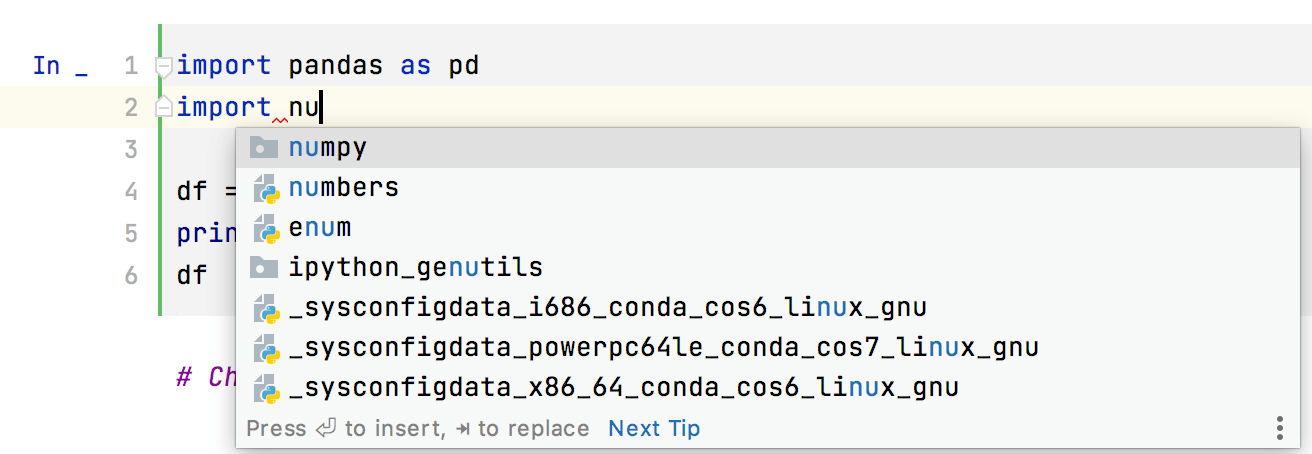
Whenever you open a curly brace in an ordinary string literal, JetBrains DataSpell provides the same completion suggestions as for an f-string. When you select one of the suggested options, the IDE automatically converts the literal into an f-string by adding a missing f prefix and a closing curly brace.

Multiple carets
You can edit multiple lines simultaneously. For example, you can add comment markers to multiple lines, or remove some characters in several occurrences of a word.
To add or remove multiple carets, press and hold Shift+Alt and click at the next location of the caret.
Alternatively, to add multiple carets, you can press Ctrl twice, and then without releasing it, press the Up or Down arrow keys. You can also make a multiple selection by pressing Shift+Alt and dragging the caret.
To delete all added carets, press Escape.
You can make a multiple selection of code in columns. To enable or disable the column selection mode, press Alt+Shift+Insert or use the context menu of the editor.
This mode is helpful when you want to edit several lines of code simultaneously. Place the caret at a symbol you need and either drag it up or down, or select a block of code and press the specified shortcut to achieve the same result.
You can change the behavior of the caret move when you press Alt+↑/↓. The default behavior is to move the caret to the end of the current word. To change this setting, open settings Ctrl+Alt+S and navigate to . In the Caret Movement section, select an appropriate behavior from the list.

Parameter hints
Parameter hints show the names of parameters in methods and functions to make your code easier to read. By default, parameter hints are enabled and shown only for values that are literals or function expressions but not for named objects.
Configure parameter hints
Open the Settings/Preferences dialog Ctrl+Alt+S and go to .
Select Parameter hints from the list, make sure the Show parameter hints checkbox is selected, and then specify the context where you want parameter hints shown.
For some methods and functions, JetBrains DataSpell does not show parameter hints in any context. Click Exclude list... to view these methods and functions, possibly enable parameter hints for them, or add new items to the list.
Code folding
Folded code fragments are shown as shaded ellipses (![]() ). If a folded code fragment contains errors, JetBrains DataSpell highlights the fragment in red.
). If a folded code fragment contains errors, JetBrains DataSpell highlights the fragment in red.
To configure the default code folding behavior, in the Settings/Preferences dialog Ctrl+Alt+S, go to .
Expand or collapse code elements
To fold or unfold a code fragment, press Ctrl+NumPad -/ Ctrl+NumPad +. JetBrains DataSpell folds or unfolds the current code fragment, for example, a single method.
To collapse or expand all code fragments, press Ctrl+Shift+NumPad -/ Ctrl+Shift+NumPad +.
JetBrains DataSpell collapses or expands all fragments within the selection, or, if nothing is selected, all fragments in the current file, for example, all methods in a file.
To collapse or expand code recursively, press Ctrl+Alt+NumPad -/ Ctrl+Alt+NumPad +. JetBrains DataSpell collapses or expands the current fragment and all its subordinate regions within that fragment.
To fold blocks of code, press Ctrl+Shift+.. This action collapses the code fragment between the matched pair of curly braces
{}, creates a custom folding region for that fragment, and makes it "foldable".To collapse or expand doc comments in the current file, in the main menu select .
To collapse or expand a custom code fragment, select it and press Ctrl+..
You can fold or unfold any manually selected regions in code.
Fold or unfold nested fragments
To expand the current fragment and all the nested fragments, press Ctrl+NumPad *, 1. You can expand the current fragment up to the specified nesting level (from 1 to 5).
To expand all the collapsed fragments in the file, press Ctrl+Shift+NumPad *, 1. You can expand the collapsed fragments up to the specified nesting level (from 1 to 5).
Use the Surround With action
You can collapse or expand code using the action.
In the editor, select a code fragment and press Ctrl+Alt+T.
From the popup menu, select <editor-fold...> Comments or region...endregion Comments.
Optionally, specify a description under which the collapsed fragment will be hidden.
To collapse or expand the created region, press Ctrl+..
To navigate to the created custom region, press Ctrl+Alt+..
Disable code folding outline
You can disable the code folding outline that appears on the gutter.
In the Settings/Preferences dialog Ctrl+Alt+S, go to .
Clear the checkbox.
Autosave
JetBrains DataSpell automatically saves changes that you make in your files. Saving is triggered by various events, such as compiling, running, debugging, performing version control operations, closing a file or a project, or quitting the IDE. Saving files can be also triggered by third-party plugins.
Most of the events that trigger auto-save are predefined and cannot be configured, but you can be sure that changes will not be lost and you can find all of them in local history.
Configure autosave behavior
Press Ctrl+Alt+S to open IDE settings and select Appearance and Behavior | System Settings.
Under Autosave, configure the following options:
Save files when switching to a different application or a built-in terminal
Save files is the IDE is idle for N seconds
If you use version control integration, names of all modified files will be marked with a dedicated color on the file tab. But you can also mark unsaved files with an asterisk (*) on the file tab.
Mark files with unsaved changes
Press Ctrl+Alt+S to open IDE settings and select Editor | General | Editor Tabs.
Select the Mark modified (*) checkbox.
Revert changes
For most recent changes, including refactorings, press Ctrl+Z or choose from the menu.
For a more detailed view of past changes, use Local History.
For the most robust tracking of all changes, use a version control system.
Refactorings
Use the Rename refactoring to change names of symbols, files, and all the references to them throughout code.
Rename
In the editor, select an element you want to rename. If you need to rename a file, select one in the Project tool window.
Press Shift+F6 or from the main menu, select .
In the Rename dialog, enter a new name of the element to enable the Preview and Refactor buttons.
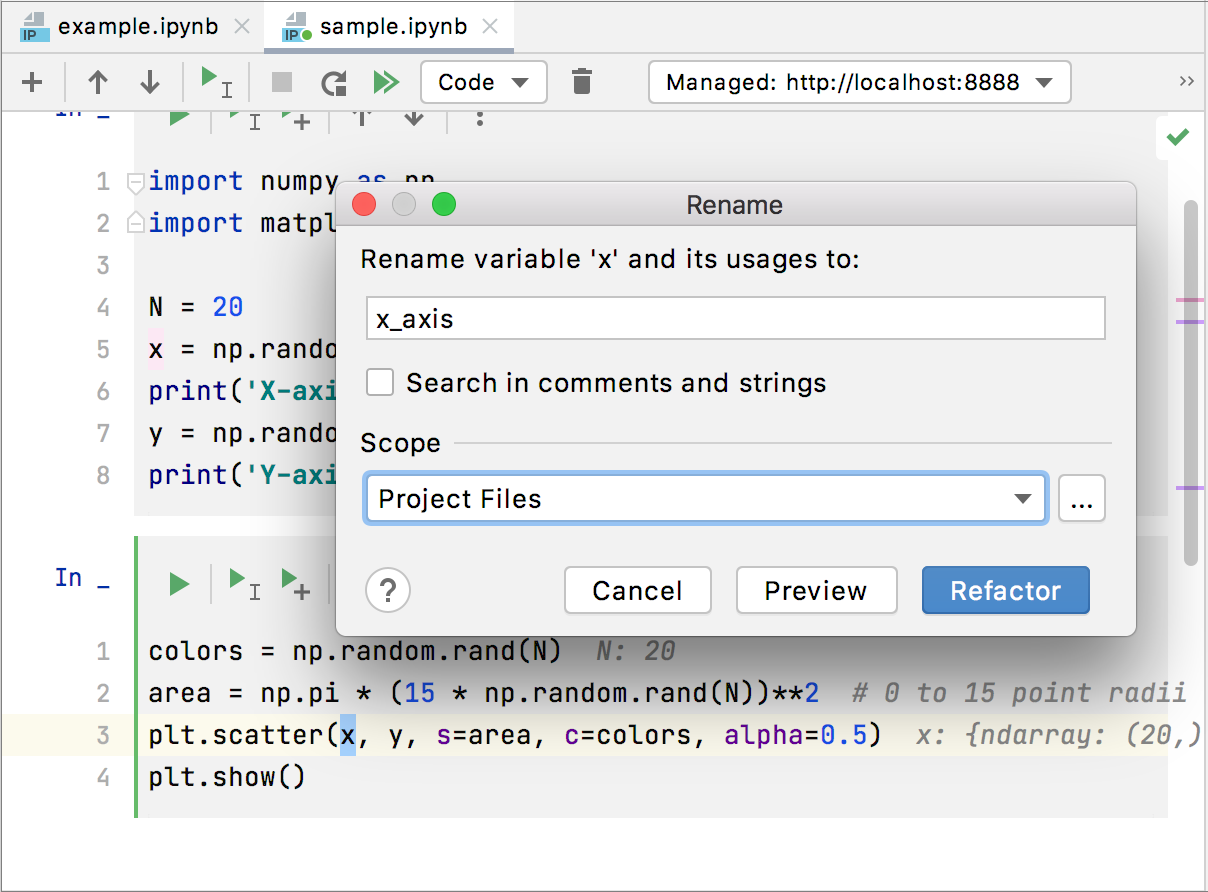
You can specify additional options. For example, specify where to search for element occurrences, or what else to rename. You can also specify a scope for the refactoring.
Click Preview to see the potential changes or click Refactor.
When you click Preview, JetBrains DataSpell opens the Find tool window with the results of found usages where you can check the results and confirm the refactoring (Do Refactor ).
All the occurrences of the element will be renamed.
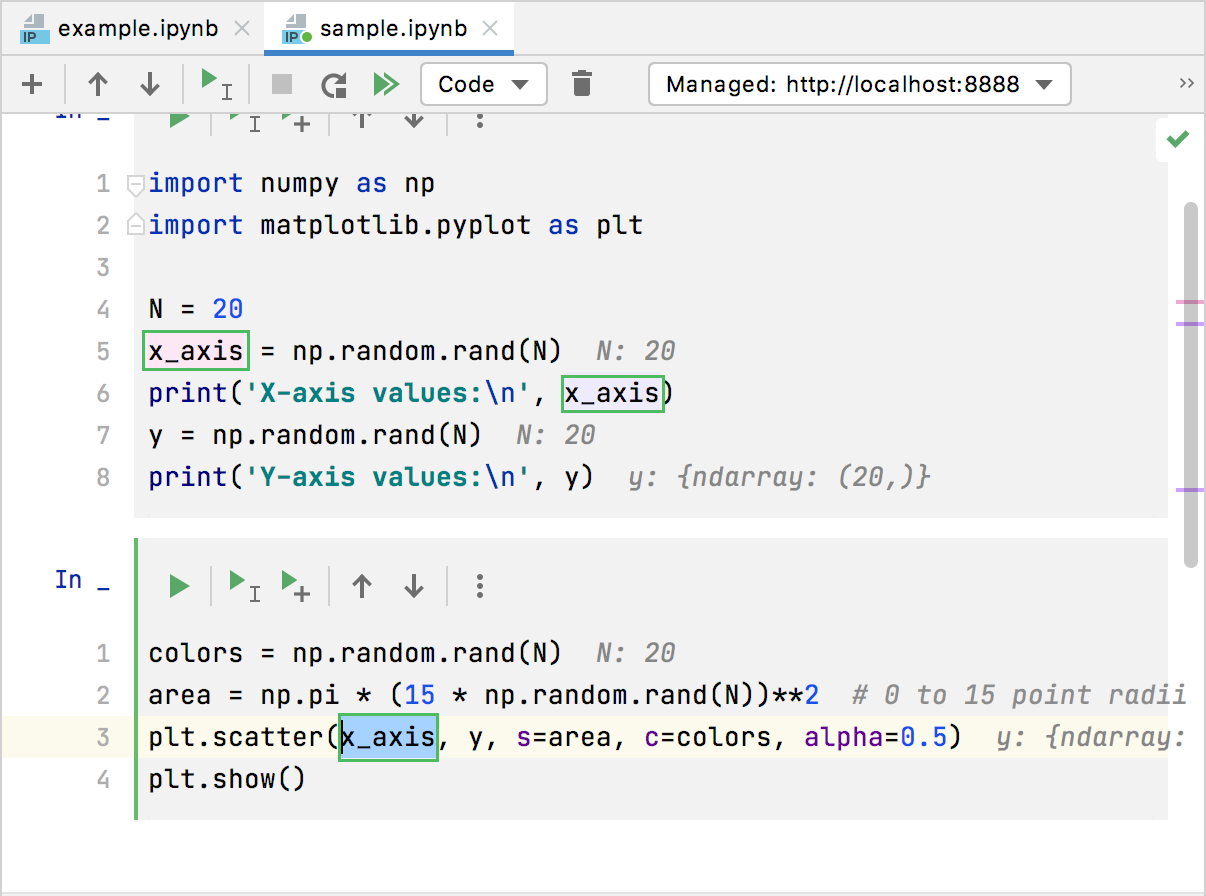
Next time you invoke the Rename refactoring, JetBrains DataSpell remembers the options you have specified inside the Rename dialog.
With Extract and Introduce refactorings you can quickly declare variables, constants, parameters, fields, and methods:
Extract/Introduce Constant: makes your source code easier to read and helps you avoid using hardcoded constants without any explanations about their values or purpose.
Extract/Introduce Variable: places a complex or duplicated expression into a separate variable that is less complex and easier to understand.
Extract/Introduce Field: lets you declare a new field and initialize it with the selected expression.
Extract/Introduce Parameter: adds a new parameter to a function declaration.
Extract/Introduce Method: lets you take a code fragment that can be grouped, move it into a separated method, and replace the old code with a call to the method.
Extract and Introduce
Select a code element to refactor. From the main menu, select .
In the Refactor This popup window, select the target refactoring, for example, Introduce Variable...
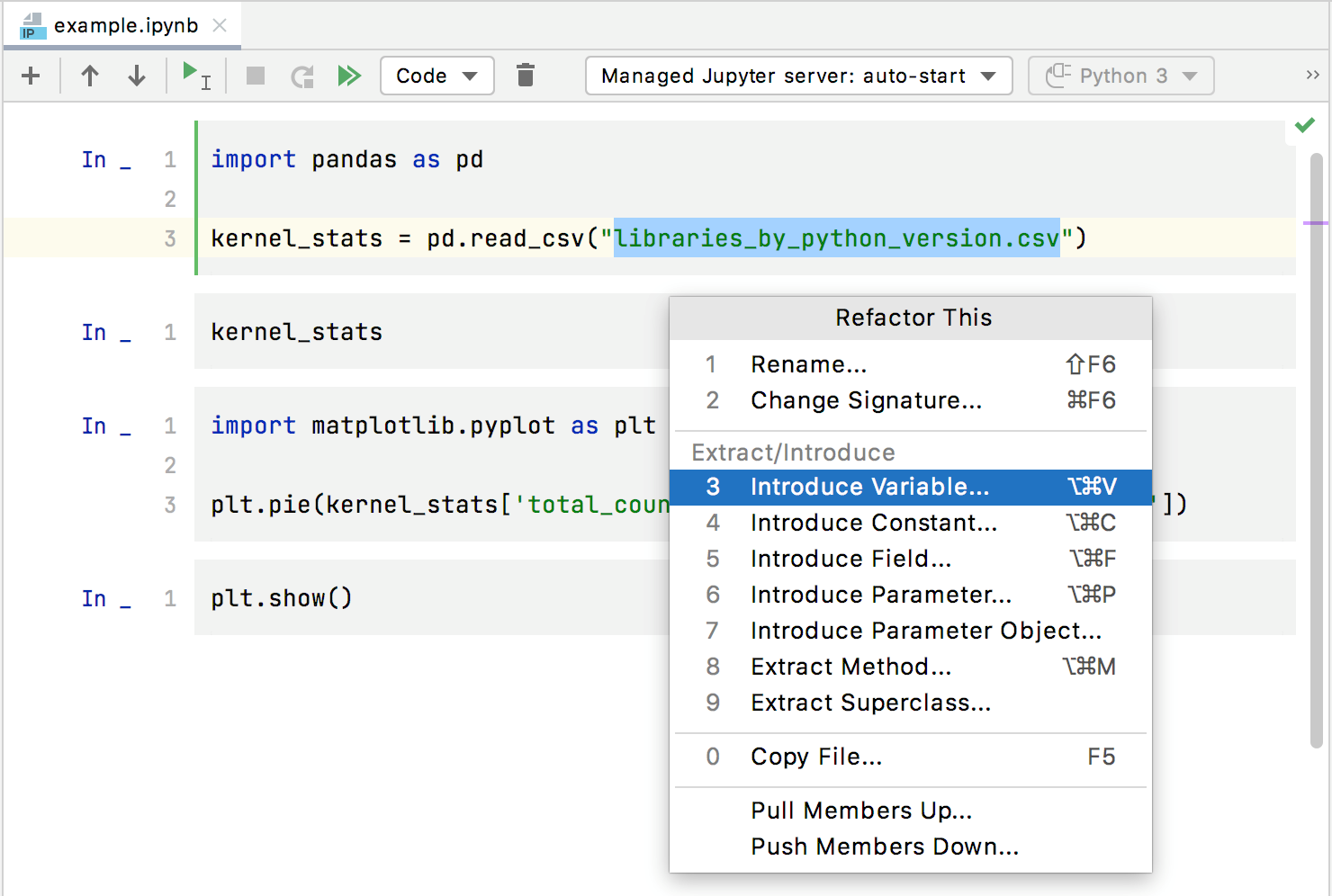
JetBrains DataSpell provides you with the list of possible variable names. You can pick one or type a name of your choice.
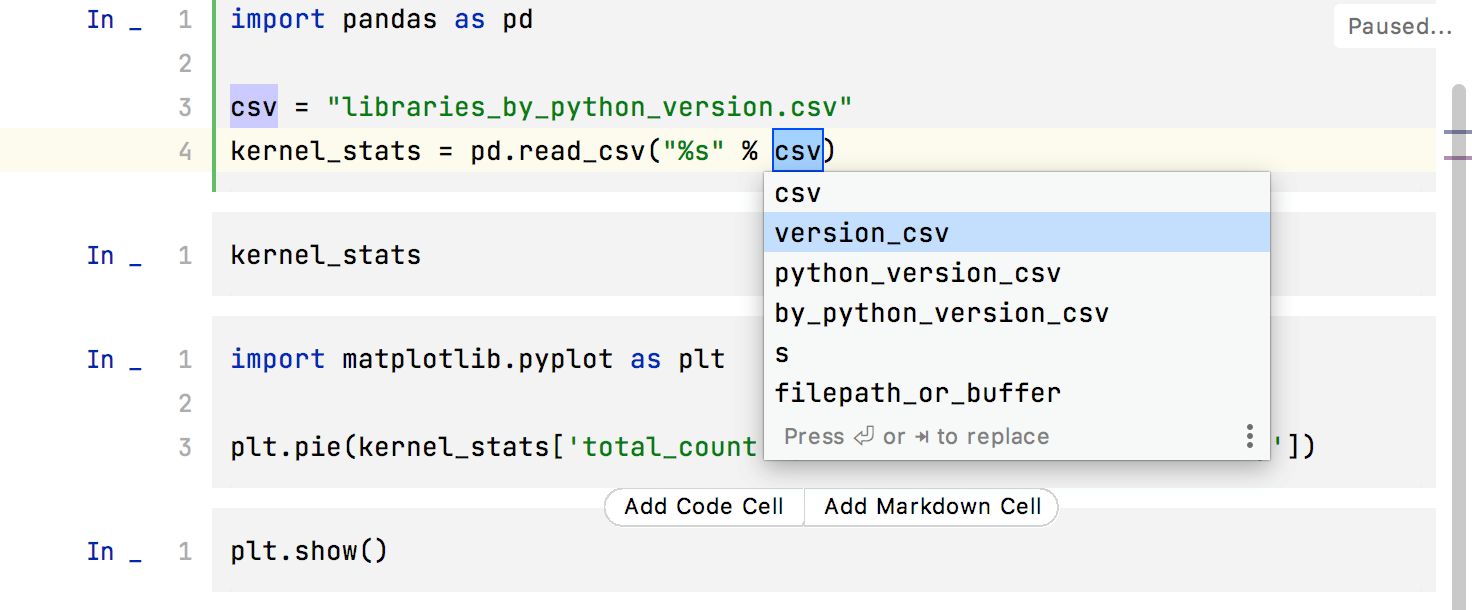
Reformat code
JetBrains DataSpell lets you reformat your code according to the requirements you've specified in the Code Style settings.
To access the settings, in the Settings/Preferences dialog Ctrl+Alt+S, go to . See Configuring code style for details.
Reformat a code fragment in a file
In the editor, select a code fragment you want to reformat.
From the main menu, select or press Ctrl+Alt+L. The IDE notifies you on the result of reformatting.
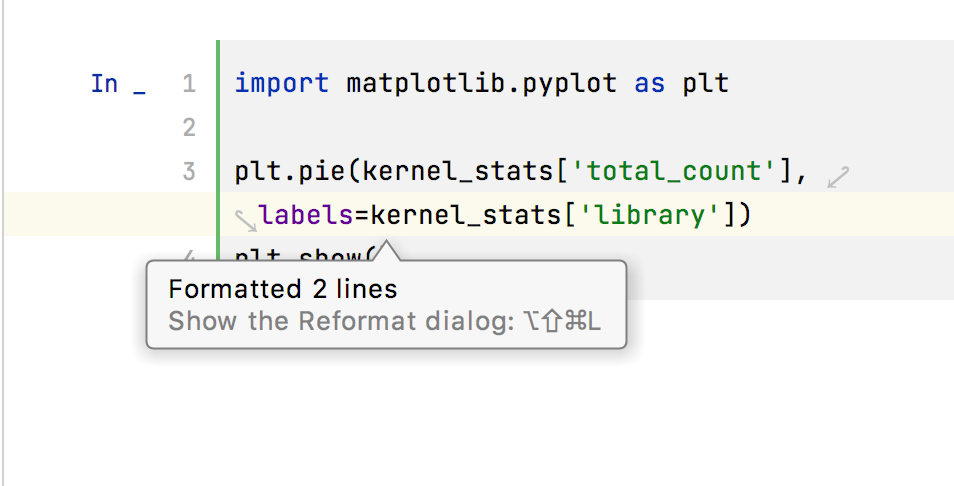
If you don't select a code fragment, JetBrains DataSpell will reformat the whole file.
Reformat a file
Either open your file in the editor and press Ctrl+Alt+Shift+L or in the Workspace tool window, right-click the file and select .
Keep pressing Shift and select additional files for a group reformatting.
In the dialog that opens, if you need, select the following reformatting options:
Optimize imports: select this option if you want to remove unused imports, add missing ones, or organize import statements.
Rearrange entries: select this option if you need to rearrange your code based on the arrangement rules specified in the code style settings.
Only VSC changed text: select this option to rearranged only fragments that have been modified in the version control system.
Cleanup code: select this option to run the code cleanup inspections.
If you want to see the exact changes made to your code during the reformatting, use the Local History feature.